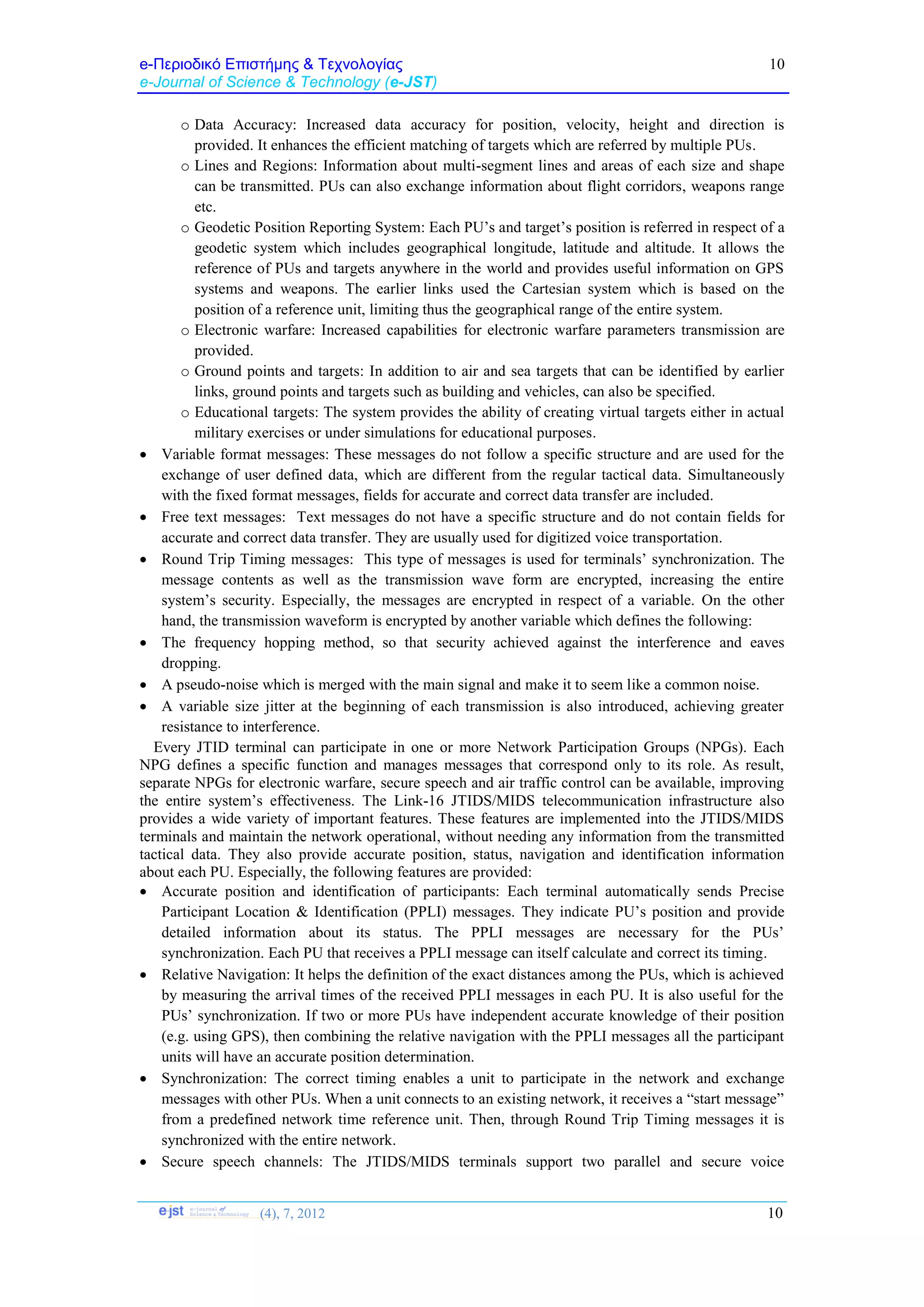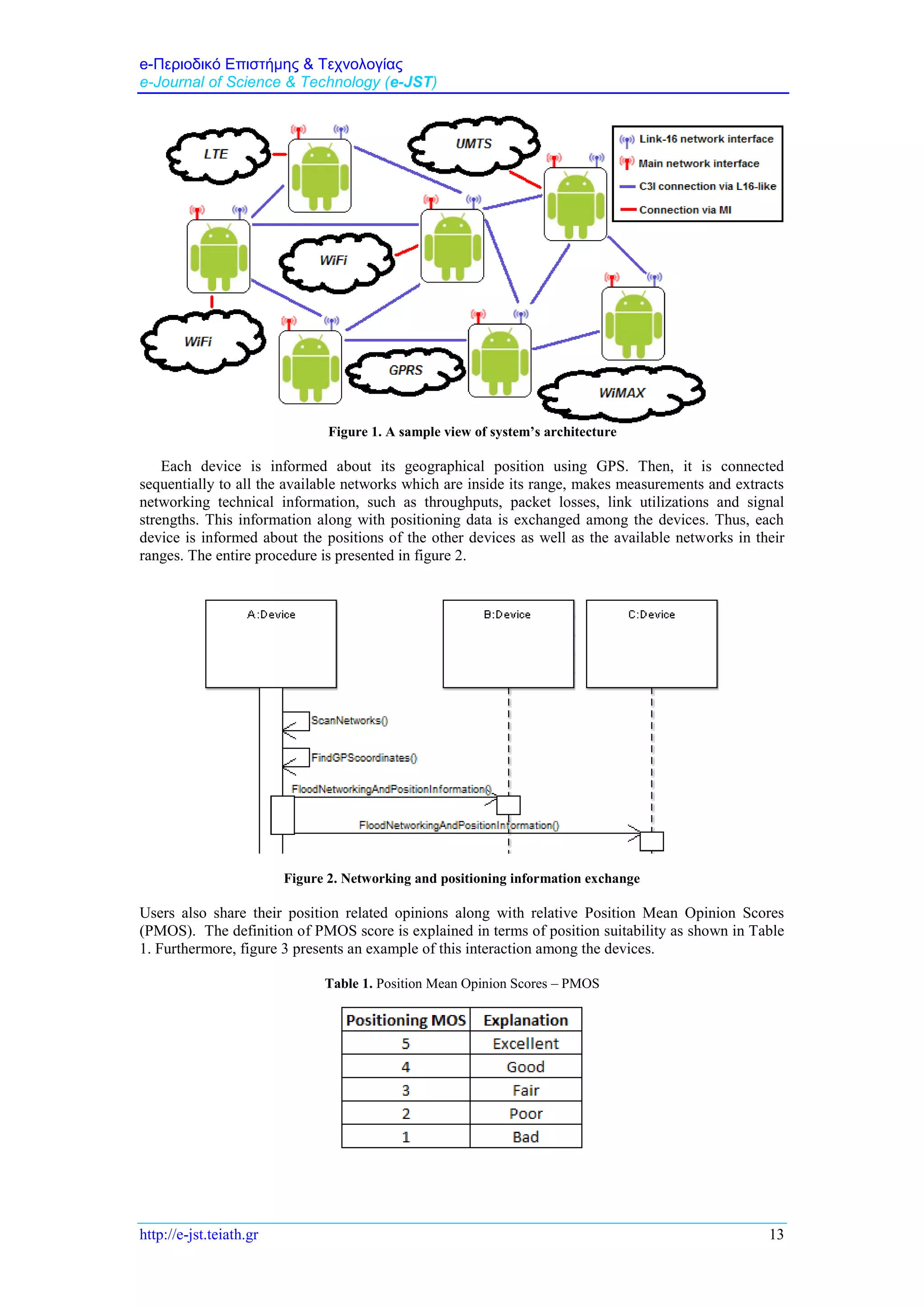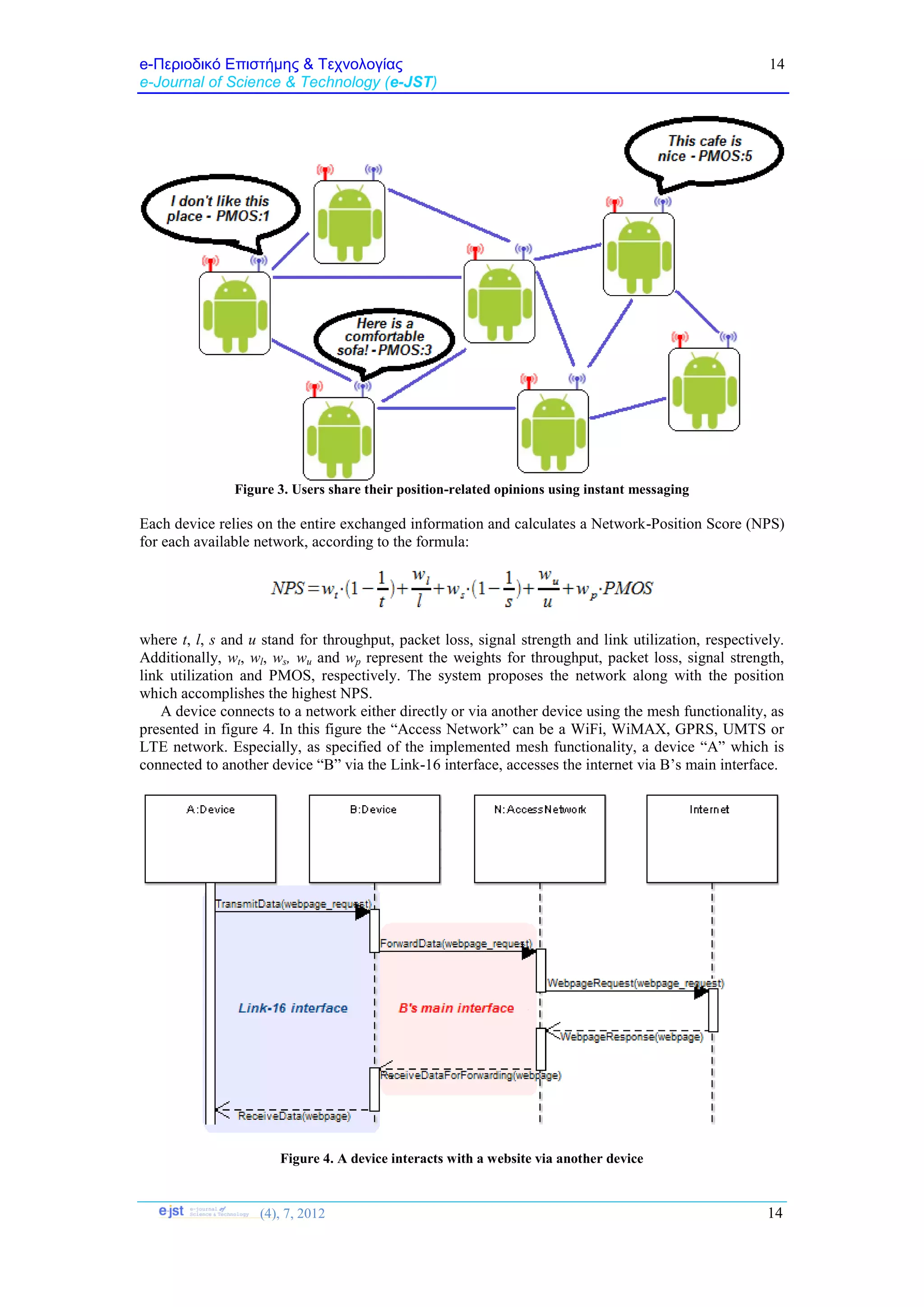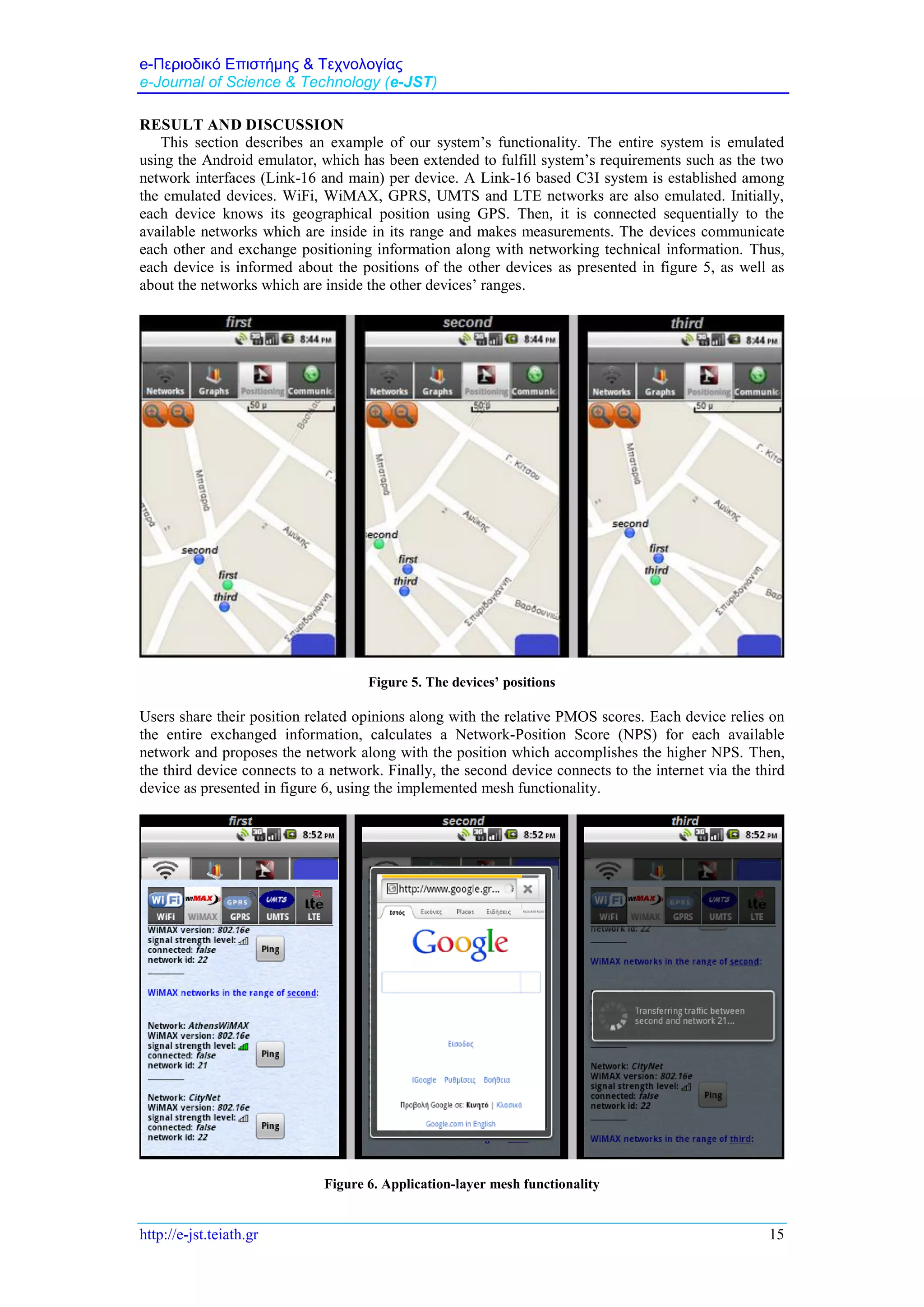The paper discusses a Link-16 based command, control, communication, and intelligence (C3I) system designed to enhance technical networking and positioning information among mobile devices. Each device utilizes GPS for geographical positioning, enabling users to receive tailored network and position proposals based on available wireless networks and shared opinions. The research emphasizes the integration of military technologies into civilian applications, aiming to improve the quality of life through advanced networking capabilities.
![e-Περιοδικό Επιστήμης & Τεχνολογίας
e-Journal of Science & Technology (e-JST)
http://e-jst.teiath.gr 7
A Network and Position Proposal Scheme using a Link-16 based C3I
System
Emmanouil Skondras1
, Kyriaki Kokoli2
, Georgios Bekiaris3
Department of Informatics
Athens University of Economics and Business
10434 Athens, Greece
e-mail: manolisskondras@yahoo.gr1
, kokoli.korina@gmail.com2
, bekiarisgeorgios@hotmail.com3
ABSTRACT
The smart usage of hi-end military technological solutions in daily activities makes people life better.
This paper describes a network and position proposal scheme in respect of technical networking and
positioning information. A Link-16 based Command, Control, Communication and Intelligence (C3I)
system is established among the mobile devices. Each device knows its geographical position using its
GPS. A network along with a possible good position for user’s service is proposed, fulfilling his/her
requirements for comfortable work.
Key words: Network selection, position proposal, Link-16, C3I systems, WiFi, WiMAX, GPRS,
UMTS, LTE
INTRODUCTION
Nowadays, the wide spread of wireless networks has challenged the research community into the
development of sophisticated network selection schemes. In addition, military research and
development departments have produced state of the art technologies which can offer usable solutions
for making people life better. The proposed scheme combines technical networking information with
position related users’ opinions to accomplish network proposal along with position proposal. A Link-
16 based C3I system is established among the mobile devices. Each device knows its geographical
position using its GPS. Technical information about the WiFi, WiMAX, GPRS, UMTS and LTE
networks which are inside the range of each device as well as positioning information is exchanged.
Thus, each device is informed about the positions of the other devices and the available networks in
their ranges. Users also share their position related opinions. The system relies on the entire exchanged
information and accomplishes the network as well as the position proposal. It is also notable that each
device can connect to a network either directly or via another device in mesh mode.
The remainder of the paper is organized as follows. Firstly, related research literature as well as an
overview of the standards followed in this study is described. Then, the software architecture that
supports the prototype application, the software elements and modules are presented. The final section
concludes our work and presents possible future extensions.
MATERIALS AND METHODS
Related Work
The rapid increase of wireless network technologies has lead into the development of sophisticated
network selection schemes. This section makes an overview of some network selection approaches
proposed by the scientific literature.
The work presented in [1] describes a user-centric network selection scheme. It is based on user
preferences as well as on cross-layer information including application, link and physical layers.
Furthermore, it is applied in a heterogeneous network environment and also takes into account vertical
handover situations. The network selection along with the handover decisions are made by the user
equipment. In addition, the proposed network selection and handover optimization intends on the
reduction of handovers’ frequency. The authors propose three algorithms for handovers’ frequency
reduction. According to their experimental results, these algorithms achieve a successful balance of the
user requirements with the handovers’ frequency.
The authors of [2] describe a network selection scheme for IEEE 802.11 networks. The available
networks are evaluated according to the PSQA method. Objective Quality of Service (QoS) parameters
such as bandwidth, jitter and packet loss are combined with subjective Quality of Experience (QoE)
parameters such as "the video quality is good". The QoE parameters are estimated in respect of the
Mean Opinion Score (MOS) technique. Especially, a Random Neural Network (RNN) is used for](https://image.slidesharecdn.com/6anetworkandpositionproposalschemeusingalink-16basedc3isystem-191212145253/75/A-Network-and-Position-Proposal-Scheme-using-a-Link-16-based-C3I-System-1-2048.jpg)
![e-Περιοδικό Επιστήμης & Τεχνολογίας
e-Journal of Science & Technology (e-JST)
(4), 7, 2012 8
8
statistical learning of the MOS scores and provides automated QoE evaluation for each network.
According to the authors, the prerequisites to enable the application of the PSQA methodology are the
following:
Step 1 - Quality-affective factors and Distorted Video Database: QoS factors are selected and a
range of values for each factor is defined. A set of factors along with specific values is called
“configuration”. Then, a video database which contains many configurations is created.
Step 2 - Subjective Quality Assessment: Subjective evaluation of the configurations which are
contained in the video database is carried out, according to the MOS methodology. Two similar
databases which contain the configurations and the relative MOS scores are created. The first one
is referred as “training database” and the second as “validation database”.
Step 3 - Learning of the quality behavior with RNN: The result of the step 2 is a qualitative
evaluation of the video database’s contents that created in stage 1. The RNN receives as input the
training database and attempts to train itself according to its data. A function f() verifies if the
"knowledge" which is acquired by the RNN converge in respect of the validation database. If the
RNN’s knowledge is relatively close to the validation database, the RNN is positively evaluated.
Otherwise, a review of diverge data is performed, until the RNN be well trained.
When a user needs to make a network selection, each access point informs him/her about its estimated
QoE. This information comes from previous connected users to the access point and is included in
either beacon or probe response frames. The user defines his/her minimum requirements for QoE in
respect of the MOS scale. User’s terminal takes into account only the networks that meet the minimum
QoE requirements and performs the network selection.
The authors of [3] propose a network selection scheme that uses mobility related factors. It is
applied in heterogeneous networking environments which include UMTS, WiMAX, WiFi and
Bluetooth networks. The networks are classified into two groups. The first one is referred as
“ubiquitous networks” and includes UMTS and WiMAX networks. The second group includes WiFi as
well as Bluetooth networks and is referred as “hot spot networks”. The authors assume that the
deployment of hotspot networks is independent of the ubiquitous networks and can be modeled using
the Poisson point process [4]. The algorithms SAW [5], MEW [6], TOPSIS [7] and GRA [8] are used
for network ranking. Several experiments are presented and the importance of mobility related factors
is demonstrated.
[9] describes a network selection scheme which is applied in a heterogeneous network environment,
consisted of WiFi, WiMAX, UMTS and LTE networks. The entire mechanism leads on the selection of
the best network, according to the current networking conditions as well as to potential future network
states. Furthermore, the proposed scheme is evaluated in comparison with two other network selection
strategies, the predefined and the opportunistic. The predefined strategy selects the network that
provides the higher signal strength. A key disadvantage of this strategy is that the higher signal strength
does not always imply on a high QoS level. On the other hand, the opportunistic strategy selects the
network that provides the best QoS. It leads on a large number of handovers, in respect of the rapidly
and dynamically changed networking environment. The goal of the proposed scheme is the balance of
the provided QoS with the total number of handovers, which leads on a more efficient usage of the
entire network resources.
Materials
This section presents an overview of the technologies that are used by the proposed scheme. These
technologies include the GPS [10], Link-16 tactical data link [11], C3I systems [12], Ad-hoc [13] and
Mesh networking architectures [14] as well as WiFi [15], WiMAX [16], GPRS [17], UMTS [18] and
LTE [19] networks.
GPS
The Global Positioning System (GPS) relies on a grid of satellites to make available positioning
services. Precise positioning information about the terminals, such as geographical longitude, latitude,
altitude, speed and direction of motion, is provided. In conjunction with mapping software this
information can be graphically illustrated. The positioning system forms a global network, which
covering land, sea and air. The entire GPS infrastructure is consisted of:
Space segment: It consists of a satellite network, in which all satellites are flying at a height of
12552 miles or 20200 kilometers above the sea level.
Ground control segment: It includes ground centers, which offer manipulation and support](https://image.slidesharecdn.com/6anetworkandpositionproposalschemeusingalink-16basedc3isystem-191212145253/75/A-Network-and-Position-Proposal-Scheme-using-a-Link-16-based-C3I-System-2-2048.jpg)
![e-Περιοδικό Επιστήμης & Τεχνολογίας
e-Journal of Science & Technology (e-JST)
http://e-jst.teiath.gr 9
functionalities.
End user segment: It is also referred as user equipment or GPS terminal. It can be used during a
simple walking, in vehicles or maritime vessels and usually has small dimensions.
Link-16
The Link-16 is a state of the art technology that fulfills the limitations of all previous NATO’s
tactical data links. It is also referred as Tactical Data Information Link-J (TADIL-J) and operates in the
range of the UHF Lx Band (960-1215 MHz). Bi-directional tactical, voice and navigation data
communication among the Participating Units (PUs) is provided. Frequency modulation, frequency
hopping and time-sharing methodologies are also applied. The defined architecture does not contain
fixed nodes and thus there is no single point of failure.
The major infrastructure is consisted of two main terminal types, the Joint Tactical Information
Distribution Systems (JTIDS) and the Multifunction Information Distribution Systems (MIDS). In each
JTID, predefined time slots for data transmission and reception, are assigned. Slots’ lengths are equal to
1/128 seconds or 7.81 milliseconds. Additionally, each slot is divided into 51 frequencies, which are
inside the range of the UHF Lx Band. It is a 3MHz gap between adjacent frequencies. Special filters
exclude sub-spectra of 1008-1053MHz and 1065-1113MHz, which are used by the IFF [20] and
TACAN [21] systems, respectively. Parallel communication on multiple sub-networks is made
available, simply by giving a different frequency hopping method to each sub-network. Thus, sub-
networks with specific missiles can be created. A PU participates only on one sub-network during a
time slot. Also, different frequencies are used for downlink and uplink. These frequencies are changed
every 13 milliseconds according to a predefined pseudo-random frequency hopping algorithm. There
are 128 possible sub-networks available for use, but due to the limitation of the 51 frequencies, almost
30 sub-networks can operate in parallel without interferences. If there are parallel transmissions in the
same frequency, a terminal takes into account only the closest transmission to it, in respect of the
received signal strength.
The Link-16 provides increased data transmission rates compared with the older tactical data links.
It also supports a variety of messages that did not exist in earlier links. Furthermore, in addition to the
regular tactical data, extra functionalities are provided, such as air-navigation data transmission.
Therefore, the real increase of the exchanged data volume exceeds the 300% compared with older
links.
The messages of Link-16 consisted of two parts, the header and the data. The header provides meta-
information about the message, such as the message type and the source PU. The data part contains the
tactical information. The following message types are defined:
Fixed format messages: These messages are also referred as “J series messages” and used for
tactical data exchange. Fields for accurate and correct data transfer are included. Innovative
functionalities that improve the effectiveness of tactical data exchange compared with the earlier
data links are provided, such as:
o Number of Participants: In each PU a unique address is assigned. It is a five digit octal number
inside the range of 00001-77777, which enables a maximum support for 32,767 different PUs.
To better understand the importance of this upgrade in compare with earlier links, the Link-11
[22] accepts three digit octal addresses inside the range of 001-177, which enables a maximum
support for only 127 PUs.
o Number of Targets: A five digit octal number inside the range 00001-77777 or AA000-ZZ777
is assigned to each target. It enables a maximum support for 524,284 different targets and
results in an extremely increase in compare with the 4.092 possible targets that are supported
from earlier links.
o Target quality: The quality of the targets is related to the accuracy of each target’s position
reporting. Its values are inside the range of 0-15 providing accuracy better than 20 meters. To
understand the importance of this upgrade in compare with earlier links, the Link-11 defines
values from 0 to 7 and its accuracy is worse than 3 nautical miles.
o Target identity: Each target’s identity includes features such as target’s activity, platform type
and ethnicity.
o Status Filial PUs: It provides detailed status information of the filial PUs that includes
equipment state, communication channels with radars and missiles, fuel levels and weapons’
capabilities. This type of information does not provided by earlier links.](https://image.slidesharecdn.com/6anetworkandpositionproposalschemeusingalink-16basedc3isystem-191212145253/75/A-Network-and-Position-Proposal-Scheme-using-a-Link-16-based-C3I-System-3-2048.jpg)


![e-Περιοδικό Επιστήμης & Τεχνολογίας
e-Journal of Science & Technology (e-JST)
(4), 7, 2012 12
12
GPRS, UMTS and LTE
The General Packet Radio Service (GPRS) is standardized by the European Telecommunications
Standards Institute (ETSI). It provides internet access over the Global System for Mobile
Communications (GSM), which is the world’s leading standard in digital cellular networks. Peak data
rates up to 114 Kbps are provided. Two major network elements are introduced, the Serving GPRS
Support Node (SGSN) and the Gateway GPRS Support Node (GGSN). The SGSN interacts with the
mobile stations and also maintains information about their locations. Additionally, it communicates
with the GGSN. Finally, the GGSN is a gateway that provides access to a data network.
The 3GPP Universal Mobile Telecommunications System (UMTS) is applied in cellular network
topologies. Data rate up to 384Kbps along with mobility support is offered. In addition, transmission
rates are increased up to 2Mbps for stationary users. The High Speed Downlink Packet Access
(HSDPA) and the High Speed Uplink Packet Access (HSUPA) provide data rates’ improvements.
Especially, these technologies are essential evolution of UMTS. They provide data rates up to
14,4Mbps and 5,8Mbps for the downlink and uplink, respectively. A UMTS network consists of two
main entities, the core network (CN) and the UMTS Terrestrial Radio Access Network (UTRAN). The
CN is responsible for routing telephone calls as well as for data connections to external networks. The
CN consists of two sub-domains, the circuit-switched (CS) and packet-switched (PS). The CS sub-
domain provides access to PSTN/ISDN infrastructures, while the PS provides access to IP networks.
The UTRAN is responsible for the wireless part of the network. It consists of a radio network controller
(RNC) and NodeBs which provide coverage in the corresponding cells. A NodeB is connected to the
user equipment (UE) as well as to the RNC.
The 3GPP Long Term Evolution (LTE) enhances the UMTS in a variety of features. LTE provides
improved specifications compared with the previous cellular systems’ generation. These specifications
include peak data rates up to 300 Mbps for downlink and 75Mbps for uplink as well as more effective
QoS. LTE integrates the Orthogonal Frequency Division Multiplex (OFDM) technology. Two access
schemes are defined, one for the downlink and one for the uplink, respectively. Especially, the
downlink uses Orthogonal Frequency Division Multiple Access (OFDMA). On the other hand, the
uplink uses Single Carrier Frequency Division Multiple Access (SC-FDMA). MIMO is also supported
and enhances the entire system’s efficiency. A key element of the LTE architecture is the Evolved
Universal Terrestrial Radio Access Network (EUTRAN). It contains a node which is named eNodeB
(eNB) and interacts with the User Equipment (UE). The eNB also implements the physical (PHY),
Medium Access Control (MAC), Radio Link Control (RLC) and Packet Data Control Protocol (PDCP)
layers of the LTE architecture. Functions such as radio resource management, scheduling, QoS
manipulation and admission control are also performed by the eNB.
Methods
The proposed scheme combines technical networking information with position related users’
opinions, to accomplish network and position proposal. It is implemented over the Android mobile
platform [23] which has been extended for supporting the Link-16 technology. Each device has two
network interfaces, a Link-16 as well as a main interface. A C3I system, which is used for information
exchange among the devices, is established using their Link-16 interfaces. The Link-16 provides
enhanced security, stability and interference robustness to the C3I system. Especially, the Android
devices are considered as the PUs of the Link-16 architecture and communicate each other using the
Link-16’s message types. On the other hand, the main interface is used for interaction with WiFi,
WiMAX, GPRS, UMTS and LTE networks. Figure 1 presents a sample view of system’s architecture.](https://image.slidesharecdn.com/6anetworkandpositionproposalschemeusingalink-16basedc3isystem-191212145253/75/A-Network-and-Position-Proposal-Scheme-using-a-Link-16-based-C3I-System-6-2048.jpg)



![e-Περιοδικό Επιστήμης & Τεχνολογίας
e-Journal of Science & Technology (e-JST)
(4), 7, 2012 16
16
CONCLUSION
The proposed scheme is implemented over the Android platform. It combines technical networking
information with position related users’ opinions, to perform network and position proposal. A Link-16
based C3I system is constructed among the mobile devices. Each device is informed about its
geographical position using GPS. Networking technical information about WiFi, WiMAX, GPRS,
UMTS and LTE networks along with geographical positioning information is exchanged among the
devices. Users also share their position related opinions along with relative PMOS scores. A NPS score
is calculated according to the entire exchanged information and the network as well as the position
which accomplishes the highest score is proposed. Finally, each Android device can connect to a
network either directly or via another device using the mesh functionality.
References:
[1] Xuejun Cai, Ling Chen, Sofia Rute, Yanqi Wu, “Dynamic and User-Centric Network Selection in
Heterogeneous Networks”, 26th
IEEE International Performance Computing and Communications
Conference, pp. 538-544, New Orleans, Louisiana, USA, April 11-13, 2007
[2] Kandaraj Piamrat, Adlen Ksentini, Cesar Viho, Jean-Marie Bonnin, “QoE-based Network Selection
for Multimedia Users in IEEE 802.11 Wireless Networks”, 33rd
IEEE Conference on Local Computer
Networks, pp. 388-394, Montreal, Quebec, Canada, October 14-17, 2008
[3] Lusheng Wang, David Binet, “Mobility-based Network Selection Scheme in Heterogeneous
Wireless Networks”, 69th
IEEE Vehicular Technology Conference, pp. 1-5, Barcelona, Spain, April 26-
29, 2009
[4] H.Q. Nguyen, F. Baccelli, D. Kofman, “A Stochastic Geometry Analysis of Dense IEEE 802.11
Networks”, 26th
IEEE International Conference on Computer Communications, pp. 1199-1207,
Anchorage, Alaska, USA, May 6-12, 2007
[5] K. Savitha, C. Chandrasekar, “Vertical Handover decision schemes using SAW and WPM for
Network selection in Heterogeneous Wireless Networks”, vol. 11, issue 9, pp. 18-24, Global Journals
Inc., USA, May 2011
[6] Milena Medineckiene, Folke Bjork, “Owner preferences regarding renovation measures - The
demonstration of using multi-criteria decision making”, Journal of Civil Engineering and Management,
vol. 17-2, pp. 284-295, Taylor & Francis, 2011
[7] Aggeliki Sgora, Christos A. Gizelis, Dimitrios D. Vergados, “Network selection in a WiMAX-WiFi
environment”, Pervasive and Mobile Computing Journal, vol. 7, issue 5, pp. 584-594, Elsevier B.V.,
October 2011
[8] Song Zhao, Wenxiao Shi, Shaoshua Fan, Nan Wang, “A GRA-based network selection mechanism
in heterogeneous wireless networks”, International Conference on Computer, Mechatronics Control
and Electronic Engineering, vol. 6, pp. 215-218, Changchun, China, August 24-26, 2010
[9] Haleh Tabrizi, Golnaz Farhadi. John Cioffi, “A Learning-based Network Selection Method in
Heterogeneous Wireless Systems”, IEEE Global Communications Conference, pp. 1-5, Houston, USA,
December 5-9, 2011
[10] Fabio Dovis, Paolo Mulassano, Fabrizio Dominci, “Overview of global navigation satellite
systems”, Handbook of Posotion Location: Theory, Practice and Advances - First Edition, ch. 28, pp.
923-974, John Wiley & Sons Press, 2012
[11] He Zhao-xiong, Liu Xing, Liu Xue-min, Zhou Jing-lun, “Link-16 model architecture for multiple
nets simulation in NS-2”, IEEE 17th
International Conference on Industrial Engineering and
Engineering Management, pp. 1645-1649, Xiamen, China, December 7-10, 2010
[12] James W. Cusack, “Advanced command, control, communications & intelligence (C3I) systems
analysis and trade-offs”, Air force research laboratory information directorate, Rome, New York, USA,
March 2004](https://image.slidesharecdn.com/6anetworkandpositionproposalschemeusingalink-16basedc3isystem-191212145253/75/A-Network-and-Position-Proposal-Scheme-using-a-Link-16-based-C3I-System-10-2048.jpg)
![e-Περιοδικό Επιστήμης & Τεχνολογίας
e-Journal of Science & Technology (e-JST)
http://e-jst.teiath.gr 17
[13] Giuseppe Anastasi, Marco Conti, Enrico Gregori, “IEEE 802.11 Ad hoc networks: protocols,
performance and open issues”, Mobile Ad Hoc Networking, ch. 3, pp. 69-116, IEEE press, 2004
[14] Tsai-Wei Wu, Hung-Yun Hsieh, “Internetworking Wireless Mesh Networks: Performance
Characterization and Perspectives”, 50th
IEEE Global Telecommunications Conference, pp. 4846-4851,
Washington, DC, USA, November 26-30, 2007
[15] Aboul-Magd O., “IEEE Standard 802.11 Overview”, Wireless Local Area Networks Quality of
Service:An Engineering Perspective, ch. 3, pp. 65-96, Wiley-IEEE Press, 2008
[16] C. Eklund, R. Marks, S. Ponnuswamy, K. Stanwood, N. van Waes, “IEEE 802.16 architecture”,
WirelessMAN:Inside the IEEE 802.16 Standard for Wireless Metropolitan Area Networks, ch. 4, pp.
13-27, Wiley-IEEE Press, 2006
[17] John Hoffman, “GPRS Demystified”, McGraw-Hill Telecom, Edition 1, September, 2002
[18] M. Rhee, “Universal Mobile Telecommunication System (UMTS)”, Mobile Communication
Systems and Security, ch. 5, pp. 133-166, Wiley-IEEE Press, 2009
[19] David Astély, Erik Dahlman, Anders Furuskär, Ylva Jading, Magnus Lindström, Stefan Parkvall,
“LTE: The Evolution of Mobile Broadband”, IEEE Communications Magazine, vol. 47, issue 4, pp.
44-51, IEEE, April, 2009
[20] Calvin Seah, Malini Deepan, “Identification Friend or Foe: A Necessity On The Battlefield”,
Journal of the Singapore Armed Forces, vol. 38, no.1, pp. 59-66, Pointer, 2012
[21] Jianming Gao, Chenbin Fu, Yan Liu, Ying Wei, “Behavioral modeling and EMC analysis for
Tacan system”, IEEE 4th
International Symposium on Microwave, Antenna, Propagation and EMC
Technologies for Wireless Communications, pp. 576-579, Beijing, China, November 1-3, 2011
[22] Hojun Lee, Bernard P. Zeigler, Doohwan Kim, “A devs-based framework for simulation
optimization: Case study of Link-11 gateway parameter tuning”, MILCOM: Military Communications
Conference, pp. 1-7, San Diego, USA, November 17-19, 2008
[23] Android platform, Google, http://www.android.com/](https://image.slidesharecdn.com/6anetworkandpositionproposalschemeusingalink-16basedc3isystem-191212145253/75/A-Network-and-Position-Proposal-Scheme-using-a-Link-16-based-C3I-System-11-2048.jpg)